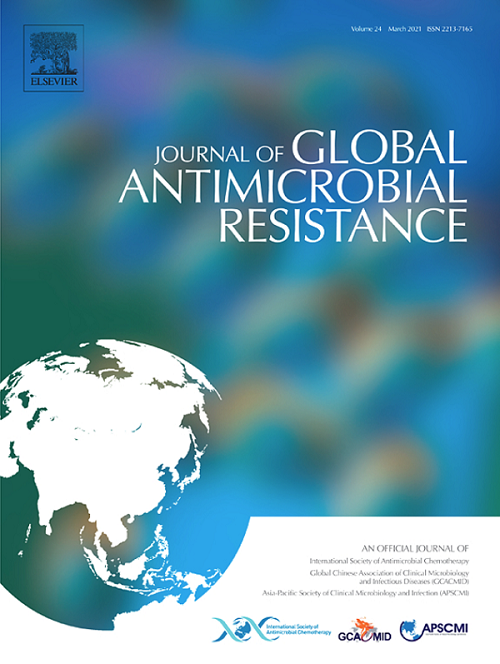与抗菌素耐药性相关的暴露因素以及确定肉鸡生产系统收获前缓解抗菌素耐药性的管理方法:系统综述。
IF 3.7
3区 医学
Q2 INFECTIOUS DISEASES
引用次数: 0
摘要
目标:本系统综述旨在[1]确定与肉鸡AMU和其他暴露因素相关的AMR发展风险,以及[2]确定最佳管理方法,以减轻肉鸡生产过程中收获前肠道细菌中AMR的发展:研究选择标准采用 PECO/PICO 框架,包括肉鸡(群体)、AMU 或其他管理方法(暴露或干预)、有机或无抗生素生产(参照物)以及 AMR 肠道细菌/基因的存在(结果)。2022年12月19日在PubMed和2023年2月10日在AGRICOLA、Embase、Scopus和Web of Science中检索了经过同行评议的主要研究。采用改良的 ROBIS-E 偏倚风险评估工具对研究的偏倚风险进行评估。结果:对 205/2699 项研究进行了全文综述,其中 15 项纳入最终综述。肠道细菌大肠埃希菌、沙门氏菌和弯曲杆菌对几种对人类健康至关重要的抗菌药物(氨基糖苷类、头孢菌素类、氯霉素类、大环内酯类、青霉素类、喹诺酮类、四环素类和磺胺类)表现出AMR和多药耐药性(MDR)。在肉鸡生产中使用 AMU,细菌发生 AMR 的风险可能更高。不合标准的农场管理方法、不良的生物安全措施和传统的生产系统也与细菌中 AMR 的传播有关:研究结果表明,暴露于 AMU 与肠道细菌中 AMR 的发展风险相当高。抗菌药物管理、有机/无抗生素肉鸡生产、良好的农场管理规范和高级生物安全措施可大大减轻收获前肠道细菌中 AMR 的发展。然而,大多数研究都是横断面研究,因此无法确定因果关系。本文章由计算机程序翻译,如有差异,请以英文原文为准。
Exposure factors associated with antimicrobial resistance and identification of management practices for preharvest mitigation along broiler production systems: A systematic review
Objective
This systematic review aimed to (i) determine the risk of antimicrobial resistance (AMR) development associated with antimicrobial use (AMU) and other exposure factors in broilers, and (ii) identify best management practices to mitigate preharvest AMR development of enteric bacteria alongside broiler production.
Methods
Study selection criteria comprised the population, exposure or intervention, comparator, and outcome framework and included broiler (population), AMU or other management practices (exposure or intervention), organic or antibiotic-free production (comparator), and the presence of AMR-enteric bacteria/genes (outcome). Peer-reviewed primary research studies were searched in PubMed on 19 December 2022, and AGRICOLA, Embase, Scopus, and Web of Science on 10 February 2023. The risk of bias in studies was assessed using the modified ROBIS-E risk of bias assessment tool. The results were synthesised and presented narratively according to PRISMA 2020 guidelines.
Results
In total, 205/2699 studies were subjected to full-text review, with 15 included in the final synthesis. Enteric bacteria Escherichia coli, Salmonella, and Campylobacter exhibited AMR and multidrug resistance against several critically important antimicrobials (aminoglycoside, cephalosporin, chloramphenicol, macrolide, penicillin, quinolone, tetracycline, and sulfonamide) for human health. The risk of AMR development in bacteria was shown to be potentially higher with AMU in broiler production. Substandard farm management practices, poor biosecurity measures, and conventional production systems have also been associated with the dissemination of AMR in bacteria.
Conclusions
Our findings indicate that AMU exposure is associated with considerably higher risk of AMR development in enteric bacteria. Antimicrobial stewardship, organic/antibiotic-free broiler production, good farm management practices, and high-level biosecurity measures are able to substantially mitigate preharvest AMR development in enteric bacteria. However, most of studies were cross-sectional, and therefore causal inference cannot be established.
求助全文
通过发布文献求助,成功后即可免费获取论文全文。
去求助
来源期刊

Journal of global antimicrobial resistance
INFECTIOUS DISEASES-PHARMACOLOGY & PHARMACY
CiteScore
8.70
自引率
2.20%
发文量
285
审稿时长
34 weeks
期刊介绍:
The Journal of Global Antimicrobial Resistance (JGAR) is a quarterly online journal run by an international Editorial Board that focuses on the global spread of antibiotic-resistant microbes.
JGAR is a dedicated journal for all professionals working in research, health care, the environment and animal infection control, aiming to track the resistance threat worldwide and provides a single voice devoted to antimicrobial resistance (AMR).
Featuring peer-reviewed and up to date research articles, reviews, short notes and hot topics JGAR covers the key topics related to antibacterial, antiviral, antifungal and antiparasitic resistance.
 求助内容:
求助内容: 应助结果提醒方式:
应助结果提醒方式:


